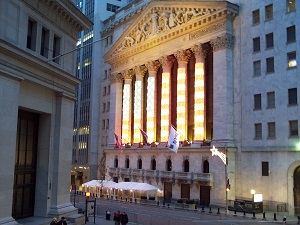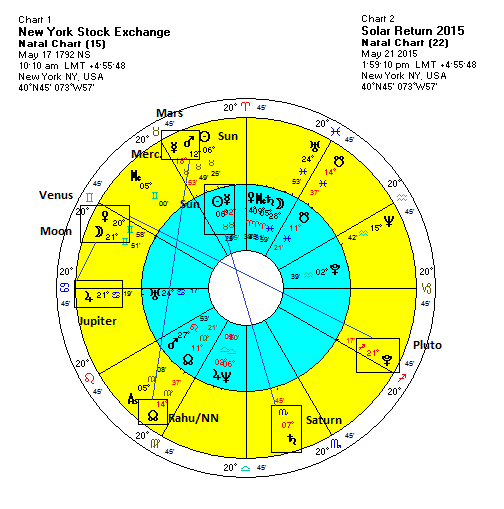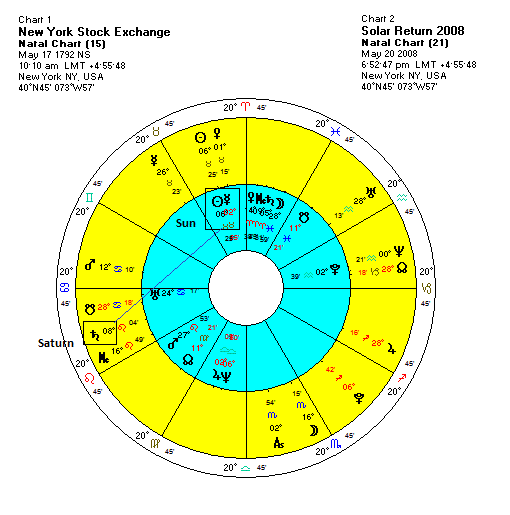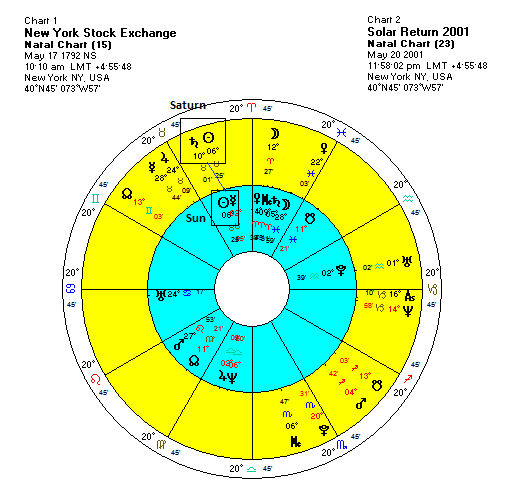 (17 May 2015)
The New York Stock Exchange is 223 years old today. On May 17, 1792,
near the corner of Broad and Wall Streets in lower Manhattan, the first
regulated trading of stocks and bonds took place. The auspiciousness of
the planets on that date would foretell the NYSE becoming the largest
and most well-known stock exchange in the world.
(17 May 2015)
The New York Stock Exchange is 223 years old today. On May 17, 1792,
near the corner of Broad and Wall Streets in lower Manhattan, the first
regulated trading of stocks and bonds took place. The auspiciousness of
the planets on that date would foretell the NYSE becoming the largest
and most well-known stock exchange in the world. As a time-based science, astrology takes special notice of birthdays. Each birthday marks the return of the Sun to its place at the time of birth. The resulting Solar Return (or Varshphal) chart can provide hints of what will happen in the year to come. When benefic planets like Venus or Jupiter are prominent in the Solar Return chart, positive outcomes are more likely. Conversely, a birthday that falls at a time when malefics like Saturn or Mars are prominent will tend to indicate a year of difficulties and challenges.
This year's Solar Return chart for the NYSE is very mixed. On one hand, there is a nice conjunction of the Moon with Venus opposite Pluto which also aligns with Jupiter in a lesser aspect. This is a generally positive pattern that suggests that stocks may enjoy significant gains between now and May 2016. On the other hand, Rahu forms an aspect with Mercury and Mars. This is unhelpful for sentiment generally as suggests instability. Even worse, there is a very close opposition aspect from Saturn to the Sun which is extremely negative. Saturn is the most bearish planet for the stock market and its hard aspects (0/90/180 degrees) are usually the most difficult. It is hard to see how stocks can move higher over the next 12 months with this close opposition aspect.

We can see how previous hard aspects of Saturn to the Sun have corresponded with significant declines. Saturn takes about 29 years to make a full revolution through the zodiac. Therefore, it takes about 7-7.5 years to move through a 90-degree arc. The last major Saturn-Sun hard aspect occurred in 2008 when global markets plunged during the Great Recession. Saturn (8 Leo) squared the Sun (6 Taurus) within just two degrees. Even though this was not a full-strength Vedic aspect, it was close enough that it likely was a major reason why the markets declined 35% from May 2008 to May 2009.

Interestingly, the previous hard Saturn aspect to the Sun before that occurred in 2001. The conjunction was almost four degrees from exact but it will still quite close. The Dow Jones Industrial average lost 16% from May 2001 to May 2002. There may well have been other negative factors in the Solar Return to account for this decline but I suspect that the Saturn-Sun conjunction was still key.

The bottom line here is that Saturn-Sun aspects that occur near the Solar Return chart on May 17th (or rather the 21st thanks to the precession of the equinoxes) will tend to have a depressing effect on the stock market. While it is only one factor, I would think that it could well outweigh other positive factors in the chart. This is another indication that stocks are likely to suffer a decline over the coming 12 months.
Weekly Financial Forecast
Stocks ended modestly higher for the most part last week on news that China cut interest rates again and would likely begin its own QE program to boost its economy. The Dow gained a half of one percent finishing at 18,272 while the Indian Sensex added one percent to 27,324. I thought we might have seen more downside on the late week Mars-Saturn aspect but stocks were actually fairly strong on Friday. Tuesday was more negative as expected, however, and that correlated closely with the entry of Mars into tropical Gemini.
This week has some significant Saturn action as Monday's sees the Moon align with Mars opposite Saturn. Generally, that should be a signal for caution. Friday's Sun-Saturn opposition aspect is also problematic as confidence is often in short supply. In between, we could see some gains as Mercury aligns with Venus.